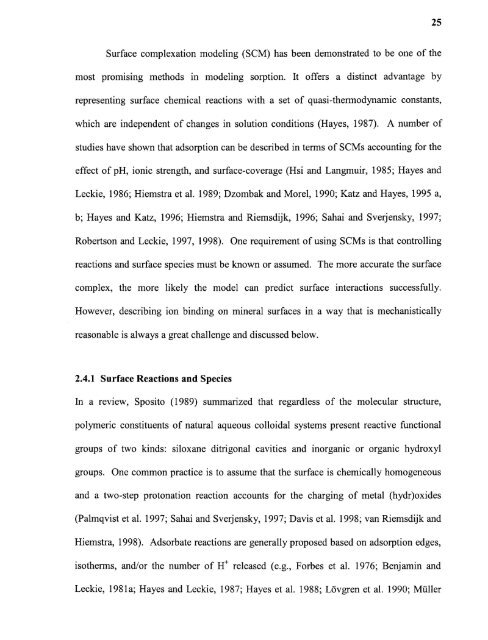Heavy metal adsorption on iron oxide and iron oxide-coated silica ...
Heavy metal adsorption on iron oxide and iron oxide-coated silica ...
Heavy metal adsorption on iron oxide and iron oxide-coated silica ...
You also want an ePaper? Increase the reach of your titles
YUMPU automatically turns print PDFs into web optimized ePapers that Google loves.
25Surface complexati<strong>on</strong> modeling (SCM) has been dem<strong>on</strong>strated to be <strong>on</strong>e of themost promising methods in modeling sorpti<strong>on</strong>. It offers a distinct advantage byrepresenting surface chemical reacti<strong>on</strong>s with a set of quasi-thermodynamic c<strong>on</strong>stants,which are independent of changes in soluti<strong>on</strong> c<strong>on</strong>diti<strong>on</strong>s (Hayes, 1987). A number ofstudies have shown that <str<strong>on</strong>g>adsorpti<strong>on</strong></str<strong>on</strong>g> can be described in terms of SCMs accounting for theeffect of pH, i<strong>on</strong>ic strength, <strong>and</strong> surface-coverage (Hsi <strong>and</strong> Langmuir, 1985; Hayes <strong>and</strong>Leckie, 1986; Hiemstra et al. 1989; Dzombak <strong>and</strong> Morel, 1990; Katz <strong>and</strong> Hayes, 1995 a,b; Hayes <strong>and</strong> Katz, 1996; Hiemstra <strong>and</strong> Riemsdijk, 1996; Sahai <strong>and</strong> Sverjensky, 1997;Roberts<strong>on</strong> <strong>and</strong> Leckie, 1997, 1998). One requirement of using SCMs is that c<strong>on</strong>trollingreacti<strong>on</strong>s <strong>and</strong> surface species must be known or assumed. The more accurate the surfacecomplex, the more likely the model can predict surface interacti<strong>on</strong>s successfully.However, describing i<strong>on</strong> binding <strong>on</strong> mineral surfaces in a way that is mechanisticallyreas<strong>on</strong>able is always a great challenge <strong>and</strong> discussed below.2.4.1 Surface Reacti<strong>on</strong>s <strong>and</strong> SpeciesIn a review, Sposito (1989) summarized that regardless of the molecular structure,polymeric c<strong>on</strong>stituents of natural aqueous colloidal systems present reactive functi<strong>on</strong>algroups of two kinds: siloxane ditrig<strong>on</strong>al cavities <strong>and</strong> inorganic or organic hydroxylgroups. One comm<strong>on</strong> practice is to assume that the surface is chemically homogeneous<strong>and</strong> a two-step prot<strong>on</strong>ati<strong>on</strong> reacti<strong>on</strong> accounts for the charging of <str<strong>on</strong>g>metal</str<strong>on</strong>g> (hydr)<strong>oxide</strong>s(Palmqvist et al. 1997; Sahai <strong>and</strong> Sverjensky, 1997; Davis et al. 1998; van Riemsdijk <strong>and</strong>Hiemstra, 1998). Adsorbate reacti<strong>on</strong>s are generally proposed based <strong>on</strong> <str<strong>on</strong>g>adsorpti<strong>on</strong></str<strong>on</strong>g> edges,isotherms, <strong>and</strong>/or the number of H+ released (e.g., Forbes et al. 1976; Benjamin <strong>and</strong>Leckie, 1981a; Hayes <strong>and</strong> Leckie, 1987; Hayes et al. 1988; Lövgren et al. 1990; Müner
















